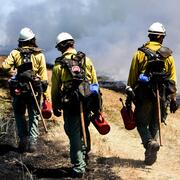Mammals
Mammals
Filter Total Items: 39
The Strain and Genetic Online Tissue Repository for Chronic Wasting Disease
The Strain and Genetic Online Tissue Repository (SAGOTR) is being developed by the USGS Fort Collins Science Center to document, track, discover, and request physical samples of Chronic Wasting Disease (CWD). SAGOTR connects natural resource managers, tissue repositories, and researchers in one online platform, making it easier to locate and share samples and support research and management of CWD...
Developing structured science syntheses for use in NEPA analyses and decision making in the Bureau of Land Management
Science information is fundamental to understanding how proposed actions on public lands may impact the environment. However, agencies often have limited time to compile and synthesize existing science. We are working with land management agencies to develop a new type of science product— structured science syntheses—for facilitating the use of science information in public lands decisions.
Land management research in support of streamlined energy development, economic growth, and wildfire management
FORT researchers provide sound science to support the Department of the Interior in its efforts to streamline reliable energy development, enhance cost efficiency in public lands management, and manage fire-prone habitats for public safety. This research is developed in partnership with resource managers from local, State, Federal and Tribal governments, industry, and nongovernmental organizations...
Research to support conservation of America’s national mammal, the bison
Once numbering in the tens of millions, plains bison ( Bison bison bison) were nearly driven to extinction with only a few hundred individuals remaining by the late 19th century. Plains bison have since recovered to approximately 20,000 animals managed in conservation herds throughout North America, yet substantial challenges to their recovery remain. The Department of the Interior (DOI) stewards...
Fish and wildlife science in support of heritage preservation, efficient decision making, wild ungulate management, and outdoor recreation
FORT researchers provide sound science to support the Department of Interior in its efforts to preserve American heritage, streamline species listing decisions and promote species recovery, manage wild horses and burros using efficient, cost-effective tools, and sustain hunting and fishing on public lands. This research is developed in partnership with resource managers from local, State, Federal...
North American Bat Monitoring Program (NABat)
Bats are essential contributing members of healthy, functioning ecosystems. They perform numerous ecosystem services like insect pest control and plant pollination, and provide enormous economic benefits through ecotourism, medical research, and novel biotechnologies. North American bats face unprecedented threats including habitat loss and fragmentation, white-nose syndrome, and wind energy...
Wildlife Economics
Wildlife economics can help us better understand, and sometimes even quantify, the various relationships between humans and wildlife species. On one hand, humans benefit significantly from wildlife, for example through activities like hunting, fishing, and wildlife viewing, or through the conservation of threatened and endangered species. On the other hand, wildlife can also impose substantial...
Economics of Outdoor Recreation
Planning and managing outdoor recreation on public land and water entails a series of choices, many of which are economic in nature. Economics is useful for informing a wide range of decision-making processes in the context of outdoor recreation management, including why people choose to engage in recreation and where, how people substitute between different types of recreation activities and...
Counting America’s Wild Horses and Burros: Better Estimates for Population Management
The Wild Free-Roaming Horses and Burros Act of 1971, as amended, states that, "It is the policy of Congress that wild free-roaming horses and burros shall be protected from capture, branding, harassment, or death; and to accomplish this they are to be considered in the area where presently found, as an integral part of the natural system of the public lands (PL 92-195, Sec. 1331, Congressional...
Geology, Geophysics, and Geochemistry Stable Isotope Laboratory (GSIL)
The GSIL is a state-of-the-art facility located on the Denver Federal Center that specializes in the measurement of light stable isotope — Hydrogen (H), Carbon (C), Nitrogen (N), Oxygen (O), and Sulfur (S) — compositions and other chemical and biomarker analytes in matrices relevant to the Earth sciences. Chemical and isotopic tracers offer novel insights into ecosystem biogeochemistry, food webs...
Food Webs and Wildlife Nutrition
Wildlife nutrition is an essential element of fitness, and contextualizing resource use within the broader framework of local and regional food webs is paramount to species health, function, and management.
Environmental Stressors
Environmental stressors that impact habitat and wildlife species include: abiotic factors (for example, land use, temperature); soil, air, and water quality (for example, eutrophication, contaminants); and disturbance (for example, fire, drought, hurricanes, species invasions). Understanding how these stressors impact ecosystems is critical to conservation and management.













